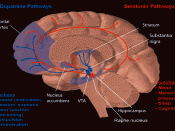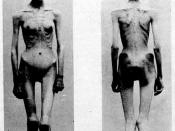ANOREXIA AND BULIMIA
Anorexia Nervosa: a condition characterized by intense fear of gaining weight or becoming obese, as well as a distorted body image, leading to an excessive weight loss from restricting food intake and excessive exercise.
Bulimia: an eating disorder in which persistent overconcern with the body weight and shape leads to repeat episodes of binging (consuming large amounts of food in a short time) associated with induced vomiting.
To support our definitions we interviewed Dr. David Praul of Charter Hospital by fax.
1. Is there a typical sufferer of Anorexia or Bulimia?
While anorexics are often members of the middle class or affluent society, recent findings show sufferers come from all backgrounds and many different styles and sizes of families. Also there is a tendency for anorexics to set unreasonably high goals and to aim for perfection in all that they do.
Generally speaking, bulimia is likely to begin after the late teens, while anorexia more often starts during adolescence.
The incidence of anorexia or bulimia in males is about 5% of all cases, with the onset of the disorders generally mid-teens to early twenties.
2. What are the causes of the eating disorders Anorexia Nervosa and Bulimia?
There are many theories, but no clear picture. It is an over simplification to blame the mass media's presentation to blame the mass media's presentation of the ideal shape: though western society's increased emphasis on the slim, fit body places pressure on many people.
We know there are many factors affecting the development of the disorders- biological, psychological and sociological- so the relationship between parent and child need not to be seen as the dominant cause. However the reluctance to mature physically (sexually) and emotionally, and the issues of personal control between parent and child, could contribute to some...


